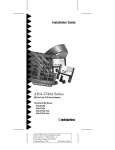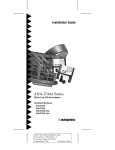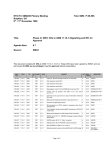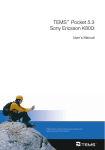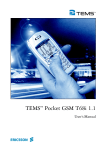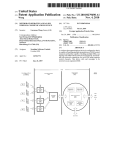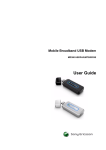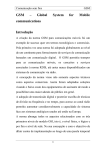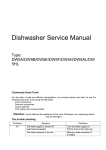Download User Guide for Network Monitoring Menu
Transcript
User Guide for Network Monitoring Menu EGSM900 DCS1800 PCS1900 Copyright © Nokia Corporation 2002. All rights reserved. Reproduction, transfer, distribution or storage of part or all of the contents in this document in any form without the prior written permission of Nokia is prohibited. Nokia and Nokia Connecting People are registered trademarks of Nokia Corporation. Other product and company names mentioned herein may be trademarks or tradenames of their respective owners. US Patent No 5818437 and other pending patents. T9 text input software Copyright (C) 1997-2002. Tegic Communications, Inc. All rights reserved. Includes RSA BSAFE cryptographic or security protocol software from RSA Security. Java™ and all Java-based marks are trademarks or registered trademarks of Sun Microsystems, Inc. Nokia operates a policy of continuous development. Nokia reserves the right to make changes and improvements to any of the products described in this document without prior notice. Under no circumstances shall Nokia be responsible for any loss of data or income or any special, incidental, consequential or indirect damages howsoever caused. The contents of this document are provided "as is". Except as required by applicable law, no warranties of any kind, either express or implied, including, but not limited to, the implied warranties of merchantability and fitness for a particular purpose, are made in relation to the accuracy, reliability or contents of this document. Nokia reserves the right to revise this document or withdraw it at any time without prior notice The availability of particular accessories may vary by region. Please check with the Nokia dealer nearest to you. Please dispose of batteries properly. 9354664 Issue 1 Contents 1. Introduction.................................................................... 2 2. Using the Field Test Display.......................................... 3 Activation and deactivation ................................................................. 3 Field test modes ....................................................................................... 4 Available tests ..........................................................................................5 3. Information on the displays.......................................... 7 3.1. Group 01: GSM signaling displays which can be visible to the network operators ................................................................................... 7 Display 01: Information on the serving cell .....................................................7 Display 02: More information on the serving cell..........................................9 Display 03: Information on the serving cell, 1st and the 2nd neighbour......................................................................................................... 11 Display 04: Information on the 3rd, 4th and 5th neighbours...................12 Display 05: Information on the 6th, 7th and 8th neighbours...................13 Display 06: Network selection display.............................................................15 Display 07: System information bits for the serving cell ...........................16 Display 08: Values of paging repeat period, TMSI, periodic location update....................................................................................................................... 17 Display 09: Network parameters .......................................................................18 Display 10: Ciphering, hopping, DTX status and IMSI................................. 19 Display 11: Uplink DTX switching display.......................................................20 Display 12: Switch BTS_TEST status.................................................................21 Display 13: Toggle Cell Barred Status..............................................................23 Display 14: Modify "last used band" ................................................................24 3.2. Group 06: GPRS signaling displays ..........................................26 Display 01: Information on the current GPRS state and previous TBF configuration...........................................................................................................26 Display 02: Previous UL TBF establishment....................................................28 Display 03: Information on the 6MM state...................................................29 Display 04: Values of P-TMSI, RAC, SMS radio priority, Ciphering and Non-DRX parameters............................................................................................30 Display 05: GPRS network parameters............................................................31 Display 06: Packet control channel parameters............................................33 Display 07: (Packet) System information parameters.................................34 Display 11: GPRS information of the serving cell and 6 neighbours......35 Appendix............................................................................ 36 1 1. Introduction This booklet describes the features and operation of the NPL-1 EGSM900, DCS1800 and PCS1900 cellular terminal with Field Test Display software. Field Test Display (i.e. Engineering Test Display or Network Monitoring Display) is a software feature available through the user interface of the NPL-1 cellular terminal. Field Test Display is available only on terminals equipped with special test software; it is not available on standard terminals. A phone with Field Test software is intended for verification of the operation of the EGSM900, DCS1800 and PCS1900 networks. It may behave differently from the normal phone in some instances, for example: • The caller's phone number is not displayed • In some cases the user interface behaves differently from that described in the user manual of the phone • The performance of the phone can sometimes be lower than that of a standard NPL-1 terminal A phone with the Field Test Display is not a calibrated measurement device, so it must be borne in mind that: • Measured values seen in the Field Test Display are approximate (e.g. RSSI levels in field test displays 01, 03, 04 and 05 in group 01) • Because the Field Test Display is not always updated in real time, the displayed values may actually have changed before they are shown to have done so on the display. The field test display may change when new SW is updated on the phone. The fields described in this document may have different values, and there may be some displays removed/added in the new SW versions. Nokia reserves the right to make changes to the features and operation of the Field Test Software. 2 2. Using the Field Test Display Activation and deactivation The Field Test Display is located at the end of the main menu loop. It can be activated (or deactivated) in the following way: 1 With the display clear, press Menu to enter the menu facility. 2 Scroll in the menu main loop to the Net monitor item and press Select. 3 Enter the index of the test to be activated at the Group/display: prompt or enter 0 to deactivate the Net monitor. The index is shown on the top left corner of the display. Example: If display 03 in group 01 should be activated enter 0103 in the prompt. 4 Confirm by pressing OK. The field test data will then appear after a moment. The index of the test will appear on the top right corner of the display. When the Field Test Display is active, the phone works in almost the same way as it does when the Field Test Display is inactive, except that the keys and scroll through the various tests, whereas they would scroll through the short code memory when the Field Test Display is inactive. There may also be some other differences compared to the operation of the normal NPL-1 terminal. The Field Test Display appears as a so-called soft indicator, which means that it is visible only if there is nothing else to display. For example, once the first digit of a phone number has been entered, the Field Test Display disappears and the entered digit is shown. After the full number has been dialled, the number disappears and the Field Test Display reappears on the screen. 3 The only way to deactivate the Field Test Display is to clear the Group/display: prompt in the Net monitor menu and enter a zero or simply enter 0000 and confirm the input by pressing OK. Field test modes There are three Field Test Display modes: • execute mode • data display mode • help mode The execute modes (in displays 11, 12 and 13 in Group 1) are entered from the menu as described above. The execute mode is of the once-off type. To run another test in the execute mode, the Net monitor menu must be re-activated. While in data display mode, the field test data (e.g. carrier, power level, cell) are visible on the main display. While in help mode, one screen of instructions is shown for each test to make it easier to indentify the test in question. To toggle between these two modes, press and hold the key. The scroll keys and offer an easy way to switch to another test without using the menu. However, the data display mode remains, i.e. nothing will be executed or set on although such tests would be passed. The help mode is also a non-execute mode. 4 Available tests The following test displays are available through the Field Test Display. Field test displays do not work with the normal terminal software; special field test software is needed. Group 01 includes GSM signaling displayes which can be visible to network operator, and group 06 includes GPRS signaling displayes. Group 01: GSM signaling displays Display 01: Information on the serving cell Display 02: More information on the serving cell Display 03: Information on the serving cell, 1st and 2nd neighbours Display 04: Information on the 3rd, 4th and 5th neighbours Display 05: Information on the 6th, 7th and 8th neighbours Display 06: Network selection display Display 07: System information bits for the serving cell Display 08: Paging repeat period, TMSI, periodic location update Display 09: Network parameters Display 10: Ciphering, hopping DTX status and IMSI Display 11: Uplink DTX switching display Display 12: Storing and removing BTS_TEST carrier Display 13: Toggle cell barred status Display 14: Modify "last used band" Group 06: GPRS signaling displays Display 01: Information on the current GPRS state and previous TBF configuration Display 02: Previous UL TBF establishment Display 03: Information on the GMM state Display 04:Values of P-TMSI, RAC, SMS radio priority, Ciphering and Non-DRX parameters 5 Display 05: GPRS Network parameters Display 06: Packet control channel parameters Display 07: (Packet) system information parameters Display 11: (GPRS information on the serving cell and 6 neighbours 6 3. Information on the displays 3.1. Group 01: GSM signaling displays which can be visible to the network operators The network operators can activate these signaling displays. Before the field test displays are visible, mobile has to be modified. With the normal production mobile, field test displays are not available. Display 01: Information on the serving cell If the mobile is on TCH (Traffic channel), e.g. during call or location update, display 1 offers the following information: Where: • a H if the carrier numbers are scrolled when hopping is on. Otherwise empty. • bbb When mobile is on TCH: DCH carrier number in decimals. When mobile is NOT on TCH: CH carrier number in decimals. When hopping is on, used carrier numbers are scrolled when display is updated. The DCH/CH-carrier number (bbb) can be shown in format Ebb, for example E22 = channel 1022. • cc RX level in dBm, - sign is not shown if cc<=-100 7 • ddd TX power level. If transmitter is on, the symbol * is shown in front of the power level value. • e Time Slot, range is 0 - 7 • ff Timing advance, range is 0 - 63 • g RX quality (sub), range is 0 - 7 • mmmm Radio Link Timeout value. If the value is negative, 0 is shown. The maximum value is 64. When the mobile is NOT on TCH then xx is shown. • nnn Value of the path loss criterion (C1). Range is -99 - 999. • ppp Value of the cell reselection criterion (C2). Range is -99 - 999. • rr Currently used band. Values: 9 = GSM900/EGSM900, • qq G is shown when MS is attached to GPRS and P is shown when MS has activated PDP context (GPRS specific displays should be followed), otherwise the location is empty. •oooo Type of current channel: 18 = DCS1800, 19 = PCS1900 THRO: TCH HR subchannel 0 THR1: TCH HR subchannel 1 TFR:TCH FR TEFR : TCH EFR F144: TCH FR data channel, speed 14.4 kbps F96: TCH FR data channel, speed 9.6 kbps F72: TCH FR data channel, speed 7.2 kbps F48: TCH FR data channel, speed 4.8 kbps F24: TCH FR data channel, speed 2.4 kbps H480: TCH HR data channel, speed 4.8 kbps, subch 0 H481: TCH HR data channel, speed 4.8 kbps, subch 1 H240: TCH HR data channel, speed 2.4 kbps, subch 0 H241: TCH HR data channel, speed 2.4 kbps, subch 1 8 FA: TCH FR signalling only (FACCH) channel FAHO : TCH HR signalling only (FACCH) channel, subch 0 FAH1 : TCH HR signalling only (FACCH) channel, subch 1 PCCCH, PBCCH, PAGCH, PNDRX: GPRS packet control channel PDTCH: GPRS traffic channel NDRX: GPRS non-DRX mode (in CCCH) SDCC : SDCCH AGCH : AGCH CCCH : CCCH CBCH : CCCH and cell broadcast receiving on BCCH : BCCH SEAR : SEARCH NSPS : MS is in No Serv Power Save state • HELP display: Display 02: More information on the serving cell Where: • aa Paging mode NO: normal paging 9 EX: extended paging RO: paging reorganization SB: same as before • b Maximum number of Random Access retransmission • c Roaming indicator, values are R or empty • Bdd Letter B and BSIC value, range is 0 - 63 • ee Reason for last call release • f • ggg RX quality (full), range is 0 - 7 Cell reselect offset, range is 0 - 126 dB. 0 - 63 * 2 dB. 'xxx' in active mode. • hh Temporary offset, range is 0 - 60 dB. 0 - 7 * 10 dB. 70 dB means infinite time, 'xx' in active mode. • iii Penalty time, range is 0 - 620 s. 0 - 31 * 20 s. 'xxx' in active mode. • j Hopping channel 0 Single RF channel 1 RF hopping channel • mm Mobile allocation index offset, MAIO Range: 00 to 63 / xx when H=0 • nn Hopping sequence number, HSN Range: 00 to 63 / xx when H=0 HELP display: 10 Display 03: Information on the serving cell, 1st and the 2nd neighbour row 1: serving cell information row 2: 1st neighbour information row 3: 2nd neighbour information row 4, ef: 1st neighbour information row 4, gh: 2nd neighbour information Where: • aaa Carrier number in decimals The DCH/CH-carrier number (bbb) can also be shown in format Ebb, for example E22 = channel 1022. • bbb C1 value, range is -99 - 999, displayed only in idle mode. Instead of the C1 value, the letter 'B' and the BSIC value will be displayed in active mode • ccc RX level in dBm, - sign is not shown if ccc<=-100 • ddd C2 value, range is -99 - 999 • e, g F is shown if cell is in a forbidden location area, otherwise the location is empty. • g, h B is barred, N is normal priority, and L is low priority, otherwise the location is empty. Neighbours 1 - 3 are affected by multiband reporting parameter (see FTD 7). There will be 0 - 3 neighbours from the other band first and the remaining places will be filled with neighbours from this band in order of RX level. 11 HELP display: Display 04: Information on the 3rd, 4th and 5th neighbours row 1: 3rd neighbour information row 2: 4th neighbour information row 3: 5th neighbour information row 4, ef: 3rd neighbour information row 4, gh: 4th neighbour information row 4, ij: 5th neighbour information Where: • aaa Carrier number in decimals The DCH/CH-carrier number (bbb) can also be shown in format Ebb, for example E22 = channel 1022. • bbb C1 value, range is -99 - 999, displayed only in idle mode. Instead of C1 value, letter 'B' and BSIC value is displayed in active mode. • ccc RX level in dBm, - sign is not shown if ccc<=-100 • ddd C2 value, range is -99 - 999 • e, g, i F is shown if the cell is in a forbidden location area, 12 otherwise the location is empty • f, h, j B is barred, N is normal priority and L is low priority, otherwise the location is empty Neighbours 1 - 3 are affected by multiband reporting parameter (see FTD 7). There will be 0 - 3 neighbours from the other band first and the remaining places will be filled with neighbours from this band in order of RX level. HELP display: Display 05: Information on the 6th, 7th and 8th neighbours row 1: 6th neighbour information row 2: 7th neighbour information row 3: 8th neighbour information row 4, ef: 6th neighbour information row 4, gh: 7th neighbour information row 4, ij: 8th neighbour information Where: • aaa Carrier number in decimals The DCH/CH-carrier number (bbb) can also be shown in format Ebb, for example E22 = channel 1022. 13 • bbb C1 value, range is -99 - 999, displayed only in idle mode. Instead of C1 value, letter 'B' and BSIC value is displayed in active mode. • ccc RX level in dBm, - sign is not shown if ccc<=-100 • ddd C2 value, range is -99 - 999 • e, g, i F is shown if the cell is in a forbidden location area, otherwise the location is empty • f, h, j B is barred, N is normal priority and L is low priority, otherwise the location is empty Neighbours 1 - 3 are affected by multiband reporting parameter (see FTD 7). There will be 0 - 3 neighbours from the other band first and the remaining places will be filled with neighbours from this band in order of RX level. The following is a quote from Phase 2+ ETSI GSM 05.08 version 5.4.0, section 8.4.3 'Additional cell reporting requirements for multiband MS': For a multi-band MS the number fo cells, for each frequency band supported, which shall be included in the measurement report is indicated by the parameter, MULTIBAND_REPORTING. The meaning of different values of the parameter is specified as follows: Value Meaning 0 (00) Normal reporting of the six strongest cells, with known and allowed NCC part of BSIC, irrespective of the band used. 1 (01) The MS shall report the strongest cell, with known and allowed NCC part of BSIC, in each of the frequency bands in the BA list, excluding the frequency band of the serving cell. The remaining positions in the measurement report shall be used for reporting of cells in the band of the serving cell. If there are still remaining positions, these shall be used to report the next strongest identified cells in the other bands irrespective of the band used. 14 2 (10) The MS shall report the two strongest cells, with known and allowed NCC part of BSIC, in each of the frequency bands in the BA list, excluding the frequency band of the serving cell. The remaining positions in the measurement report shall be used for reporting of cells in the band of the serving cell. If there are still remaining positions, these shall be used to report the next strongest identified cells in the other bands irrespective of the band used. 3 (11) The MS shall report the three strongest cells, with known and allowed NCC part of BSIC, in each of the frequency bands in the BA list, excluding the frequency band of the serving cell. The remaining positions in the measurement report shall be used for reporting of cells in the band of the serving cell. If there are still remaining positions, these shall be used to report the next strongest identified cells in the other bands irrespective of the band used. HELP display: Display 06: Network selection display This display shows the last registered network country code and network code as well as the codes for four forbidden networks and the first 3 preferred networks. row 1 : last registered network - 1st forbidden network 15 row 2: 1st preferred network - 2nd forbidden network row 3: 2nd preferred network - 3rd forbidden network row 4: 3rd preferred network - 4th forbidden network Where: • aaa country code • bb network code HELP display: Display 07: System information bits for the serving cell Where: •a 1 is shown if emergency calls are supported, else 0 •b 1 is shown if attach-detach-procedure is allowed, else 0 •c 1 is shown if half rate channels are supported, else 0 • d 1 is shown if C2 values are broadcast, else 0 •e 1 is shown if system information 7 and 8 are broadcast, else 0 • f 1 is shown if cell broadcast is supported, else 0 •g •h 1 is shown if re-establishment is supported, else 0 In idle mode 1 is shown if Early Classmark (ECSC) sending is supported, else 0. In dedicated mode 16 (conversation) X is shown. • i In idle mode 1 is shown if 2-Ter messages are supported, else 0. In dedicated mode (conversation) X is shown. •j MultiBand reporting decimal value (0,1,2,3) is shown if supported. This is shown both in idle and dedicated mode. •k 1 is shown if GPRS is supported, else 0. HELP display: Display 08: Values of paging repeat period, TMSI, periodic location update Where: • aaaaaaaa TMSI value in hex format • bbb Current value ofT3212 counter (range is 000- 'ccc', where 1 means 6 min time. So, if this value is 2 less than 'ccc' then the next periodic location updating will be made within 2*6 min = 12 minutes. • ccc Timeout value of T3212 counter (range is 000 -240, where 1 means 6 min time between location updates and 240 means 240*6 min=24h between location updates. 000 means that periodic location update is not in use). This value is received from the network. 17 • d Value of paging repeat period (range is 2-9, when paging is in every second multiframe, the mobile takes more current that if it were in every 9th multiframe) • ee Downlink signalling failure value. If the value is negative, 0 is shown. The maximum value is 45. When the mobile is on TCH, then xx is shown. • hhh Serving cell channel number The DCH/CH-carrier number (bbb) can also be shown in format Ebb, for example E22 = channel 1022. HELP display: Display 09: Network parameters Where: • aaa MCC value in decimals (MCC=Mobile Country Code) • bbb MNC value in decimals (MNC=Mobile Network Code) • ccccc LAC value in decimals (LAC=Location Area Code) • dddd Serving cell channel number • eeeee The DCH/CH-carrier number (bbb) can also be shown in format Ebb, for example E22 = channel 1022. Cell Identifier in decimals HELP display: 18 Display 10: Ciphering, hopping, DTX status and IMSI Where • aaa Ciphering value A51, A52 or OFF • bbb Hopping value ON or OFF • ccc DTX value ON or OFF • ddd IMSI attach ON: IMSI attach on OFF: IMSI attach off These values are updated only on the TCH. HELP display: 19 Display 11: Uplink DTX switching display With this display it is possible to change MS to use DTX or not if BS allows MS to decide this. This display must be activated from MENU to change the DTX state. When MENU is not active and the user is scrolling the field test displays with NEXT and PREVIOUS, the DTX state will not change. Where: • aaaaaaaaaa Status of the switched mode. The values are: DTX ON : MS uses DTX DTX OFF : MS does not use DTX DTX DEF : MS uses default state of DTX. Defined in MS_PAR.H NOT ALLOWED: BS does not allow MS to decide bbb whether it uses DTX or not. The default state of DTX. The values are ON or OFF. ccc The DTX value from BS. The values are: MAY: BS allows MS to decide whether it uses DTX or not on uplink. USE: BS controls MS to use DTX (on uplink) NOT: BS controls MS not to use DTX (on uplink) HELP display: 20 Display 12: Switch BTS_TEST status Mobile is searching only for one frequency Neighbour measurements Mobile is behaving normally. Neighbour measurements are not done. are done. This display is used to change the BTS_TEST carrier on the permament memory. If the BTS_TEST carrier is stored in the permament memory, then each time the mobile sends a search list it uses only the carrier number stored on the Mobile Station the permament memory. Also the neighbour information from the system information messages is ignored. If the BTS_TEST carrier is not stored, then the mobile behaves normally, that is, it performs the neighbour measurements according to the GSM specifications. Take the following steps to store the BTS test carrier: 1 In idle mode, press Menu. 2 Scroll in the menu main loop to the Select. Net monitor item and press 3 Select display 12 in executive mode by keying in 0112 at the Group/display: prompt. 4 When the test input prompt will be shown on the display, key in the channel number and press OK. 5 Switch power off and on. Take the following steps to deactivate BTS tests: 1 In idle mode, press Menu. 2 Scroll in the menu main loop to the Select. 21 Net monitor item and press 3 Select display 12 in executive mode by keying in 0112 at the Group/display: prompt. 4 When the test input prompt will be shown on the display, key in 3333 and press OK. 5 Switch power off and on. If the deactivation succeeded, the text BTS test off will be shown. Legal carrier numbers are: • GSM900 : 1 - 124 • DCS1800 : 512-885 • EGSM900 : 975 - 1023 NOTE: Decimal values should be used, for example 1022 = E22, for EGSM channels as the test input may be shown with a preceding E in other displays. HELP display: 22 Display 13: Toggle Cell Barred Status Only non-barred Only barred Barred and noncells are used cells are used barred cells are used This test is meant to be used when some cells are tested prior to taking them into commercial use. By setting the barring on in the base station, normal GSM phones will not try to register these barred cells. By selecting cell barring reversed, the MS will only use the cells to be tested. However, if at the same time it is required that MS will be capable of using a normal network, cell barring ignored can be set. Display 13 will show the cell barring mode. NOTE: If a cell has been selected before the barring state is changed the selected cell may have a different barring state than that shown on the display. After reselection the cell barring state definitely works. To change the barring status, perform the following steps: 1 In idle mode, press Menu. 2 Scroll in the menu main loop to the Net monitor item and press Select. 3 Select display 13 in executive mode by keying in 0113 at the Group/display: prompt HELP display: 23 Display 14: Modify "last used band" This display is applicable only in phones having both European and American frequencies. With this display it is possible to manipulate the "last used band". In multi-band products this paramater is used at startup to decide which band shall be searched first. In most cases the last used band is the most promising band to find networks in. Nevertheless, for testing purposes it is helpful to have influence on this decision. If at startup no "last used band" is found in the memory, the "Default" setting (Europe or America) will be effective. 1 Press the Menu button. 2 Scroll in the main menu loop to field test display item. 3 Press the Select button. 4 Select this display in executive mode by entering 01.14 (TEST GROUP;TEST DISPLAY) to the query prompt. 5 Test input prompt will activate, enter the desired band code (see the table below) in display. 6 Confirm with the Ok button. 7 REMOVE BATTERY or POWER SUPPLY. NOTE: In normal operation the last used band is saved to the memory at power-down. If this value is written via Test Display 01.14, the phone MUST NOT be powered off normally afterwards, because then the user-set value will be overwritten. The power supply has be interrupted instead. 24 Abbr. Server Sub Block ID aa FTD SB GSS Format R,O,I LAST_USED_BAND_SE1" Band codes: Band code Meaning 9 GSM 900 18 GSM 1800 19 GSM 1900 Other Delete stored value Mode Description HELP display: 25 Write value to memory 3.2. Group 06: GPRS signaling displays If MS is not GPRS attached, xxx will be shown on the display. Display 01: Information on the current GPRS state and previous TBF configuration Where: • a H if carrier numbers are scrolled when hopping is on. Otherwise empty. • bbbb Carrier number in decimals. If hopping is on, the used channels are scrolled when the display is updated. • ccc RX level in dBm, - sign is not shown if ccc<=-100 • dd The latest value for timing advance, range 0-63. • e Downlink time slot count in the latest TBF configuration, range 0-8. • f Uplink time slot count in the latest TBF configuration, range is 0 - 8 • g The Channel Coding Scheme of the latest downlink data block, range is 1 - 4 • h The Channel Coding Scheme of the latest uplink data block, range is 1 - 4 • ii The latest value for timing advance index, range 015. If continuous timing advance is/was not in use, xx is shown. 26 • jj TFI of the latest TBF configuration, range 0 - 31. If there is/was no downlink TBF in the latest TBF configuration, xx is shown. • kkkk MAC mode, that is, resource allocation method, used during the latest TBF configuration: DYN EDYN FIXD DUSF : USF granularity in use EUSF : USF granularity in use F_HD : Fixed Half Duplex • • m lllll Type of current channel In GPRS idle mode, if PBCCH supported in cell: PCCCH, PBCCH, PAGCH, PNDRX (non-DRX state): In GPRS idle mode, if PBCCH not supported in cell: AGCH, NDRX (non-DRX state), CCCH, BCCH In GPRS transfer mode: PDTCH Other possibilities are the same as in Display 1 in group 1. R if MS is in READY state, S if GPRS is suspended and otherwise empty. • nnnnnnnn USF values of the latest TBF configuration, the first value corresponding to timeslot 0, next to timeslot 1 and so on. The range of each USF value is 0 - 7. If there is/was no uplink TBF, or dynamic allocation was not used in the latest TBF configuration, xxxxxxxx is shown. If there is/was an uplink TBF but not all the 8 time slots are/were used, x is shown in place of the unused time slots. • HELP display: 27 Display 02: Previous UL TBF establishment • aaaaaaaaaaaa The establishment cause of the previous TBF establishment: ONE-PHASE: one-phase access request SHORT: short access request TWO-PHASE: two-phase access request PAGE RESP: paging response CELL UPD: cell update GMM SIGN: GMM or SM procedure SINGLE BL: single block without TBF establishment These correspond the establishment causes in PACKET CHANNEL REQUEST. • bbbbb PRACH if PACKET CHANNEL REQUEST was sent (PCCCH) RACH if CHANNEL REQUEST was sent (CCCH) • e Radio priority, range 1 - 4s • ccccccc Result of the TBF establishment: OK: TBF establishment succeeded. REJECT: IMM ASS REJECT (CCCH) or PACKET ACCESS REJECT (PCCCH) received from the network. TIMEOUT: No response to (P)RACH from the network. QUEUE: CS channel description received in IMM ASS (CCCH) or PACKET QUEUING NOTIFICATION received (PCCCH) and the TBF was not established (the final result may still be OK if the TBF was established correctly after queuing). FAILURE: TBF establishment failed due to any other reason. 28 dddddd The used access type, 1 -PHASE or 2-PHASE access. This informs the finally used method, regardless of the requested access type. If the TBF establishment failed, xxxxxx is shown. HELP display: Display 03: Information on the GMM state Where: • aaa Network operation mode NW1 or NW2 or NW3 • bbbbbbbb The status of GPRS attach: (xxxxxxxx is displayed in case no GPRS attach is made) BOTH: Both IMSI and GPRS attach made GPRS: GPRS attach only • hccccc The state of GMM h: main state of GMM X idle R registered D deregistered ccccc: sub state of GMM susp - suspended nocel - no cell available attu - attempting to update 29 • ddddd READY: MS is in READY state FORCE: MS is in standby state after receiving "force to standby" indication, otherwise STAND (xxxx shown if in IDLE state) • eee The used timeout value for READY timer. Unit is seconds. xxx if READY timer is deactivated. • ggg Timeout value of T3312 timer. Range 000 - 192 and unit is minutes. xxx if T3312 timer is deactivated. HELP display: Display 04: Values of P-TMSI, RAC, SMS radio priority, Ciphering and Non-DRX parameters Where: • aaaaaaaa P-TMSI value in hex format • bbbb RAC (Routing Area Code) in hex format • cccc Ciphering value (negotiated by GMM): OFF / GEA1 / GEA2 Note! Even if the value here would show that ciphering is used, LLC may still send and receive unciphered blocks. 30 • ddd SPLIT_PG_CYCLE value indicated by MS. 704 if nonDRX is used, otherwise range is 1 - 352. xxx is shown if SPLIT_PG_CYCLE is not in use in CCCH. • ee Non-DRX timer indicated by MS. (The actually used value is a minimum of this and the network parameter.) 0 if no non-DRX mode is used after transfer mode, otherwise range is 1 - 64 seconds. • f SMS radio priority, range 1 - 4. If MO SMS via GPRS is not allowed, x may be shown. HELP display: Display 05: GPRS network parameters Where: • aaaa The value of CONTROL_ACK_TYPE 4ACC: PACKET CONTROL ACKNOWLEDGEMENT is sent as 4 access bursts. CTRL: PACKET CONTROL ACKNOWLEDGEMENT is sent as RLC/MAC control block. bb • cc The value of ACCESS_BURST_TYPE, either 8 or 11 [bits]. The value of DRX_TIMER_MAX, range 1 - 64 seconds. 31 • d • ee The value of SPLIT_PG_CYCLE_CCCH_SUPPORTED, range 0 - 1. If PBCCH is supported, x is shown. Paging mode: NO: normal paging EX: extended paging RO: paging reorganization SB: same as before • fff NC mode indicated in system information. If GPRS not supported, xxx is shown. NC0: No measurement reports, MS decides of the cell re-selections NC1: Measurement reports. MS decides of the cell re-selections NC2: Measurement reports. The network commands the cell re-selections. • g The value of T3168 timer, range 0 - 7, corresponding 0.5s, 1s, ..., 4s. HELP display: 32 Display 06: Packet control channel parameters If PCCCH is not supported, xxx or 0 is shown on all fields Where: • a • g Value of BS_PBCCH_BLKS, range 1 - 4 Hopping of PBCCH H if PBCCH is hopping, otherwise empty • bb • h Value of BS_PCC_CHANS, range 1 - 16 Hopping of PCCCH H if PCCCH is hopping, otherwise empty (also if BS_PCC_CHANS=1) • cc Value of BS_PAG_BLCKS_RES, range 0 - 12 • d Value of BS_PCC_REL, range 0 - 1 • ee Value of BS_PRACH_BLKS, range 0 - 12 • f Maximum retransmissions of PRACH, range 1 - 7 HELP display: 33 Display 07: (Packet) System information parameters Where: • aaaa The location of System informtion 13. NORM: SI 13 available at BCCH Norm EXT: SI 13 available at BCCH Ext •b The availability of Packet system information 5 (optional) 0: PSI 5 not supported 1: PSI 5 supported • cc The value of PSI_REPEAT_PERIOD, range is 1 - 16. If PBCCH is not supported, xx is shown. • dd The value of PSI_COUNT_LR, range 0 - 63. If PBCCH is not supported, xx is shown. • ee The value of PSI_COUNT_HR, range 0 - 63. If PBCCH is not supported, xx is shown. • f The value of PSI_STATUS_IND, range 0 - 1. If 1, network supports the PACKET_PSI_STATUS message. HELP display: 34 Display 11: GPRS information of the serving cell and 6 neighbours row 1: serving cell information row 2: 1st neighbour on the left, 4th neighbour on the right row 3: 2nd neighbour on the left, 5th neighbour on the right row 4: 3rd neighbour on the left, 6th neighbour on the right xx is shown in all fields if MS performs cell re-selections with GSM cell re-selection algorithm, for example, if PBCCH is not supported and if neither PACKET MEAS ORDER nor PACKET CELL CHANGE ORDER has been received. Where: •a R if MS is in READY state and therefore applies hysteresis for cell re-selection. •b The value of SAME_RA_AS_SERVING_CELL: 1: cell belongs to the same routing area as the serving cell 0: cell belongs to the different routing area as the serving cell •c The value of CELL_BAR_ACCESS_2. x is shown if PBCCH is not supported. •d The value of EXC_ACC. x is shown if PBCCH is not supported. HELP display: SRyBE 1RaBE 4RaBE 5RaBE 6RaBE 2RaBE 3RaBE 35 Appendix Table 1: Frequency Band for GSM900, DCS1800 and PCS1900 Base Station Systems Rx Tx GSM900 890- 91 5 MHz 935- 960 MHz EGSM900 880- 915 MHz 925- 960 MHz DCS1800 1710-1785 MHz 1805-1880 MHz PCS1900 1850-1909 MHz 1930-1989 MHz Table 2: Channel Numbering for GSM900, DCS1800 and PCS1900 Base Station Systems Channel Rx Number Tx GSM900 Fl(n)=890+0.2*(n) 1 =< n =< 124 Fu(n)=FI(n)+45 EGSM900 Fl(n)=890+0.2*(n) 0 =< n =< 124 Fu(n)=FI(n)+45 Fl(n)=880.2+0.2* 975 =< n =< 1023 Fu(n)=FI(n)+45 Fl(n)=1710.2+0.2* (n-512) 512 =< n =< 885 Fu(n)=FI(n)+95 Fl(n)=1850.2+0.2* 512 =< n =< 810 Fu(n)=FI(n)+80 (n-975) DCS 1800 PCS1900 (n-512) Fl(n) is the center frequency if the RF channel in the lower band (Rx), and Fu(n) is the corresponding frequency in the upper band (Tx). 36






































